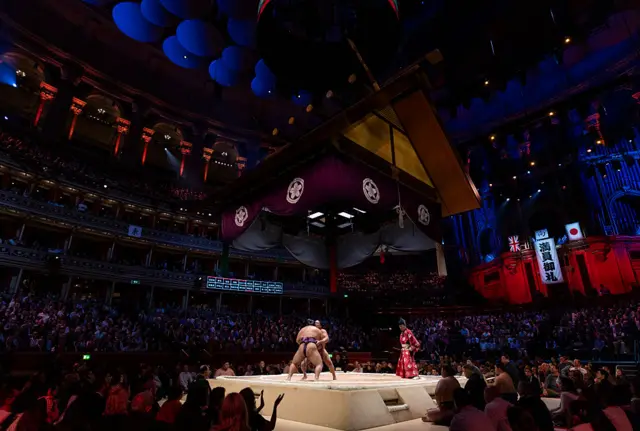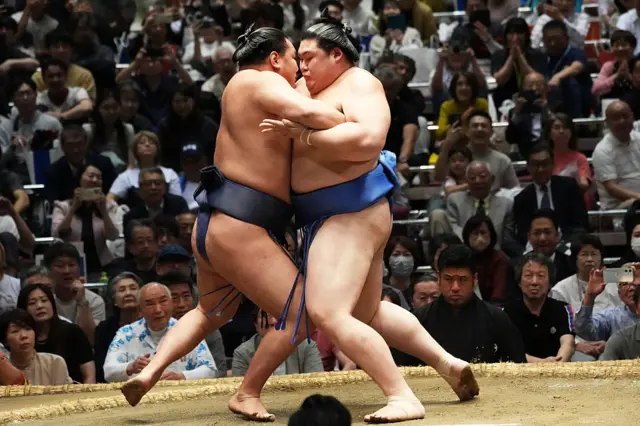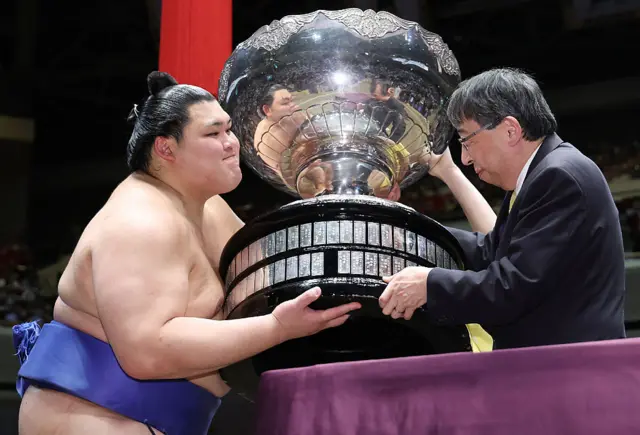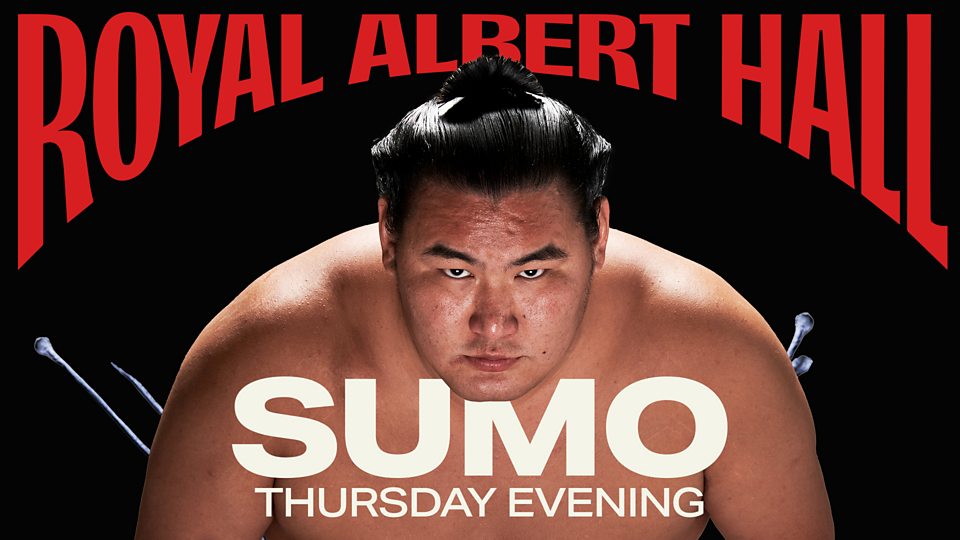David vs. Goliath moment from the Sumo!published at 19:44 BST 16 October
Tobizaru certainly flew...
Click the 'Watch live' button for BBC coverage
For the first time 34 years, the Grand Sumo Tournament will be hosted at the Royal Albert Hall in London
The event spans from 15-19 October with live coverage everyday!
Have a question? The team at Ask Me Anything are here to answer, click here to find out more
Get Involved - tell us your thoughts via WhatsApp on 03301231826 or text 81111 (UK only, standard message rates apply)
Thomas Fabbri, Erin Hughes & Saffie Yates
Tobizaru certainly flew...
Bout One - Kotoeiho
Bout Two - Shishi
Bout Three - Ryuden
Bout Four - Tobizaru
Bout Five - Sadanoumi
Bout Six - Mitakeumi
Bout Seven - Roga
Bout Eight - Churanoumi
Bout Nine - Daieisho
Bout 10 - Kinbozan
Bout 11 - Oshoma
Bout 12 - Onokatsu
Bout 13 - Wakamotoharu
Bout 14 - Gonoyama
Bout 15 - Aonishiki
Bout 16 - Takayasu
Bout 17 - Oho
Bout 18 - Tamawashi
Bout 19 - Hoshoryu
Bout 20 - Onosato
Tell us your thoughts via WhatsApp on 03301231826 or text 81111 (UK only, standard message rates apply)
So are we Steve!
Very excited to see day 2 after a storming day 1!
Steve Day
Sumo rankings are determined by each rikishi's performance in the six annual tournaments.
There are six professional sumo tournaments in a year, one every two months. They last 15 days, and each top divisions wrestler fights in one bout every day.
At the end of the tournament, the rikishi with the highest number of wins (e.g. 14 wins – 1 loss, or 13-2, etc) wins the Emperor Cup.
The Rikishi with a winning record (e.g. 8 wins -7 losses, 9-6, etc.) go up in the ranking, while those with a losing record (e.g. 7-8, 6-9, etc.) go down.
 Image source, Getty Images
Image source, Getty ImagesAhead of each tournament, a new banzuke is published, which is a single large sheet of traditional calligraphy containing the new ranking of all rikishi in professional sumo.
A rikishi's place on the banzukeregulates whether he is paid, allowed to have his own room or even live outside the stable or have an assistant.
Younger or lower ranked rikishi cook and perform chores around the heya, while higher ranked ones enjoy other special privileges.
Thomas Fabbri
from the Royal Albert Hall
Sumo wrestling has returned to London for the first time in over three decades, kicking off a five-day Grand Tournament at the Royal Albert Hall in London.
The highly anticipated return of Japan's iconic national sport has brought old and new fans alike to the same venue that hosted it in 1991.
Rikishi (sumo wrestlers) have been spotted posing for photos in front of Buckingham Palace and Big Ben, and even riding bikes around the city.
To read up on yesterday's action, click here.
Get Involved - tell us your thoughts via WhatsApp on 03301231826 or text 81111 (UK only, standard message rates apply)
It's day two after an enthralling opening last night.
Get Involved, tell us where you're watching from, who you're looking out for, are you a sumo newbie or a seasoned pro?
We want to know!
What is sumo wrestling and how much they eat in a day?
The Grand Sumo Tournament returns to London for the first time in 34 years as over 40 of Japan’s elite maku-uchi rikishi (wrestlers) will compete in the event. The Royal Albert Hall takes centre stage in the Sumo world between 15th – 19th October on Red Button, the BBC Sport website and app.
So what is it?
Sumo is the iconic national sport of Japan, but it is also a mix of tradition, discipline and Shinto religious rituals going back more than 1,000 years.
It is a combat sport with two wrestlers – called rikishi – fighting inside a raised circular ring – a dohyo – 4.55m (14.9 ft) large. Rituals and ceremonies are performed before and after each bout, highlighting the traditional nature of the sport.
Traditionally before a match, a hole is made in the centre of the dohyo and filled with nuts, squid, seaweed and sake by Shinto priests.
The hole is closed, enshrining inside a spirit. Sumo wrestlers then perform a ritual stamp and clap to scare away bad spirits.
Professional sumo is ruled by a rigid ranking system, and the wrestlers who participate dedicate their entire lives to it - living and training communally.
Written by Thomas Fabbri, BBC News
 Image source, Getty Images
Image source, Getty ImagesThe basic rules of sumo are quite simple. The bout is decided when a rikishi is forced out of the dohyo or touches the floor of the ring with anything other than the sole of his feet. Bouts can be over in a fraction of a second or last over two minutes.
There are two main fighting styles in sumo. Pusher-thrusters tend to shove their opponents out of the ring by force, while belt-fighters prefer to grapple the other rikishi and use judo-like throws.
 Image source, Getty Images
Image source, Getty ImagesHigh-ranking rikishi often excel in more than one type of combat and are able to adapt to their opponents.
There are 82 winning techniques, ranging from audacious throws to clever side-steps. The variety of techniques and strategies keeps fans fascinated, so surprises and upsets can happen in any bout.
There are no weight classes in sumo, so it is normal to see rikishi with huge size differences. Sumo rankings determine who is fighting who, rather than physical attributes.
While women can and do compete in amateur sumo wrestling around the world, they cannot enter the ring at Tokyo's 11,000 Ryogoku Kokugikan arena, or compete in professional tournaments.
Written by Thomas Fabbri, BBC News
Grand Sumo Tournament: Why is Japansese national sport in London?
The Grand Sumo Tournament is taking place outside of Japan for just the second time, with the competition taking place in London from Wednesday, 15 October until Sunday, 19 October.
London and The Royal Albert Hall also hosted the 1991 edition - the first time a tournament was staged outside Japan in the sport's history.
Explaining why the competition has gone overseas, Hakkaku Rijicho, the Japan Sumo Association chair, said he wanted to "convey to the people of London the appeal of Sumo - an ancient traditional Japanese culture".
Sumo has seen a significant rise in popularity among international fans in recent years, and a rare international tournament abroad could further boost the appeal of Japanese culture abroad. Sumo is also set to visit Paris in 2026.
 BBC Sport
BBC Sport
Watch live BBC coverage from the Royal Albert Hall
Thursday 16 October - Red Button, iPlayer, BBC Sport website and app from 19:30 BST
Friday 17 October - Red Button, iPlayer, BBC Sport website and app from 19:30 BST
Saturday 18 October - iPlayer, BBC Sport website and app from 19:30 BST
Sunday 19 October - Red Button, iPlayer, BBC Sport website and app from 14:00 BST
